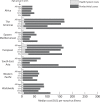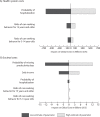Global Economic Burden of Norovirus Gastroenteritis
- PMID: 27115736
- PMCID: PMC4846012
- DOI: 10.1371/journal.pone.0151219
Global Economic Burden of Norovirus Gastroenteritis
Abstract
Background: Despite accounting for approximately one fifth of all acute gastroenteritis illnesses, norovirus has received comparatively less attention than other infectious pathogens. With several candidate vaccines under development, characterizing the global economic burden of norovirus could help funders, policy makers, public health officials, and product developers determine how much attention and resources to allocate to advancing these technologies to prevent and control norovirus.
Methods: We developed a computational simulation model to estimate the economic burden of norovirus in every country/area (233 total) stratified by WHO region and globally, from the health system and societal perspectives. We considered direct costs of illness (e.g., clinic visits and hospitalization) and productivity losses.
Results: Globally, norovirus resulted in a total of $4.2 billion (95% UI: $3.2-5.7 billion) in direct health system costs and $60.3 billion (95% UI: $44.4-83.4 billion) in societal costs per year. Disease amongst children <5 years cost society $39.8 billion, compared to $20.4 billion for all other age groups combined. Costs per norovirus illness varied by both region and age and was highest among adults ≥55 years. Productivity losses represented 84-99% of total costs varying by region. While low and middle income countries and high income countries had similar disease incidence (10,148 vs. 9,935 illness per 100,000 persons), high income countries generated 62% of global health system costs. In sensitivity analysis, the probability of hospitalization had the largest impact on health system cost estimates ($2.8 billion globally, assuming no hospitalization costs), while the probability of missing productive days had the largest impact on societal cost estimates ($35.9 billion globally, with a 25% probability of missing productive days).
Conclusions: The total economic burden is greatest in young children but the highest cost per illness is among older age groups in some regions. These large costs overwhelmingly are from productivity losses resulting from acute illness. Low, middle, and high income countries all have a considerable economic burden, suggesting that norovirus gastroenteritis is a truly global economic problem. Our findings can help identify which age group(s) and/or geographic regions may benefit the most from interventions.
Conflict of interest statement
Figures


References
-
- Institute for Health Metrics and Evaluation (IHME). Global Burden of Disease. Global Health Data Exchange 2013. Available: http://vizhub.healthdata.org/irank/arrow.php.
Publication types
MeSH terms
Grants and funding
LinkOut - more resources
Full Text Sources
Other Literature Sources
Medical

